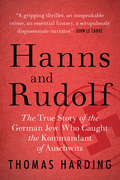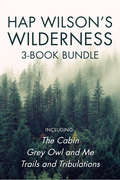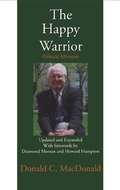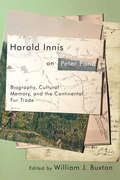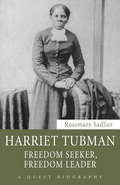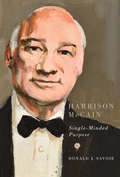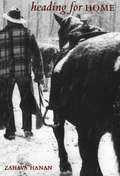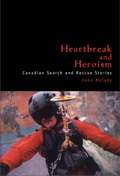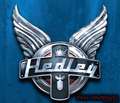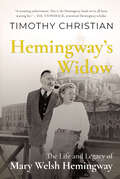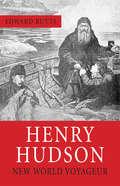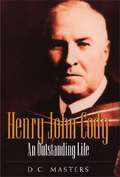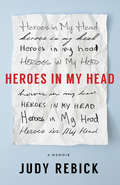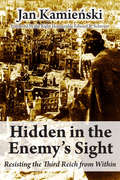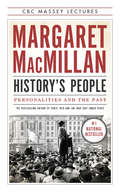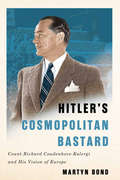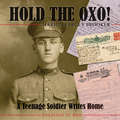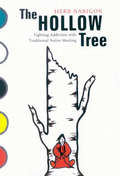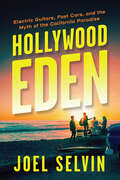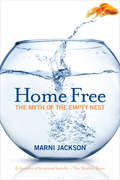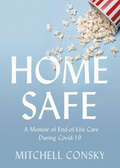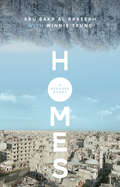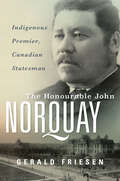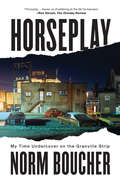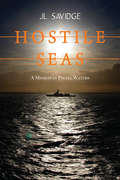- Table View
- List View
Hanns and Rudolf: The True Story of the German Jew Who Caught the Kommandant of Auschwitz
by Thomas HardingShortlisted for the 2013 Costa Biography Award. Part history, part biography, part true crime, Hanns and Rudolf chronicles the untold story of the Jewish investigator who pursued and captured one of Nazi Germany’s most notorious war criminals.May 1945. In the aftermath of the Second World War, the first British War Crimes Investigation Team is assembled to hunt down the senior Nazi officials responsible for the greatest atrocities the world has ever seen. One of the lead investigators is Lieutenant Hanns Alexander, a German Jew now serving in the British Army. Rudolf Höss is his most elusive target. As Kommandant of Auschwitz, Höss not only oversaw the murder of more than one million men, women, and children, but he perfected Hitler’s programme of mass extermination. On the run across a continent in ruins, Höss is the one man whose testimony can ensure justice at Nuremberg. Hanns and Rudolf reveals for the very first time the full, exhilarating account of Höss’s capture, an encounter with repercussions that echo to this day. Moving from the Middle-Eastern campaigns of the First World War to bohemian Berlin in the 1920s to the horror of the concentration camps and the trials in Belsen and Nuremberg, it tells the story of two German men — one Jewish, one Catholic — whose lives diverged, and intersected, in an astonishing way.
Hap Wilson's Wilderness 3-Book Bundle: The Cabin / Grey Owl and Me / Trails and Tribulations
by Hap WilsonNoted traveller and environmentalist Hap Wilson shares accounts of his lifelong involvement with wilderness living within the Canadian Shield. Wilson knows better than most how to live in the woods. As park ranger, canoe guide, outfitter, trail builder, and environmental activist, he learned from firsthand experience that nature can neither be beaten or tamed.This three-book bundle includes: The Cabin: A Search for Personal Sanctuary Noted environmentalist Hap Wilson takes us along a wilderness trail replete with snags and pitfalls, through mishaps, tears, and laughter. Grey Owl and Me: Stories From the Trail and Beyond Hap Wilson is back for another journey. Nurtured by the writings of Grey Owl, Wilson adopted a similar lifestyle to the 1930s conservationist but with his own twists and turns. Wilson recounts the early days of winter camping, takes readers to some of his favourite places, and shares intimate secrets of wilderness living. Trails and Tribulations:Confessions of a Wilderness Pathfinder Noted northern traveller Hap Wilson shares accounts of his lifelong involvement with wilderness living within the Canadian Shield. A park ranger, canoe guide, and environmental activist, Wilson takes the reader on a journey through natural settings ranging from austere to mysterious and breathtaking.
The Happy Warrior: Political Memoirs
by Donald MacdonaldOriginally published in 1988, this revised and expanded edition of Donald C. MacDonald’s acclaimed memoirs provides an inside look at provincial politics in Ontario through the eyes of a party leader. Dubbed "the Happy Warrior" by Tommy Douglas, MacDonald led the Ontario CCF/NDP for seventeen years, and continued to sit in the Legislature for twelve years after stepping down as party leader. During his political career, MacDonald played a significant role in the rise of the CCF/NDP, and provided a strong voice for the left wing in the Legislature. He also witnessed and criticized various scandals that plagued ruling parties.
Harold Innis on Peter Pond: Biography, Cultural Memory, and the Continental Fur Trade
by William J. BuxtonBest known for his writings on economic history and communications, Harold Innis also produced a body of biographical work that paid particular attention to cultural memory and how it is enriched by the study of neglected historical figures. In this compelling volume, William Buxton addresses Innis's engagement with the legacy of the fur trader and adventurer Peter Pond. Harold Innis on Peter Pond comprises eight texts by Innis, including his 1930 biography of Pond as well as his writings on the explorer's myriad activities. The book also features a collection of eight letters exchanged between Innis and Florence Cannon, a descendent of Pond with a strong interest in her ancestor's life and times, and an unpublished 1932 article on Pond's 1773–75 activities as a fur trader on the upper Mississippi, written by Innis's former student R. Harvey Fleming. Situating Innis's writings on Pond in relation to his broader body of biographical work, Buxton interprets what these texts tell us about Innis's intellectual practice, historiography, and the writing of biography. The book explores how Innis's perspectives shifted with changing intellectual and political circumstances and shows that his advocacy of Pond as an unrecognized "father of confederation" challenged conventional views of Canadian nation-building. A critical edition of previously overlooked biographical texts, Harold Innis on Peter Pond traces what these writings disclose about the biographer's character and values even as they discuss their subject.
Harriet Tubman: Freedom Seeker, Freedom Leader
by Rosemary Sadlier2013 Information Book Awards — Long-listed Harriet Tubman encouraged enslaved Africans to make the break for freedom and reinforced the potential of black freedom and independence. Born in the United States and enslaved as a child, Harriet Tubman (circa 1820-1913) is one of the best-known figures connected to the Underground Railroad. Through her knowledge and outdoor survival skills, honed through her unpaid labour in the fields and through the later connections she made in the abolitionist community, Tubman was well poised to command her followers. By her discipline and example, she never lost a "passenger." Tubman’s exploits helped to empower those opposed to slavery and enrage those who supported it. Her success encouraged enslaved Africans to make the brave break for freedom and reinforced the belief held by abolitionists in the potential of black freedom and independence. Referred to as "General Tubman" due to her contributions to the Underground Railroad and to the Union Army, Tubman’s numerous rescue missions ending in Canada helped to build the interest in escape and reinforce the position of Canada as the final stop on the journey to freedom.
Harrison McCain: Single-Minded Purpose (Footprints Series #17)
by Donald J. SavoieThe only rival to Harrison McCain’s entrepreneurial success was his deep attachment to his Maritime roots. From McCain’s beginnings in Florenceville, New Brunswick, the early mentorship he received from K.C. Irving, to the global success of his corporate empire McCain Foods, Donald Savoie presents a compelling and candid biography of one of the most famous and down-to-earth figures in Canadian business history. Savoie, a longtime friend to McCain, describes a driven, charismatic, and energetic man who had a keen wit and a deep commitment to his business and hometown. Through unprecedented access to McCain’s papers and interviews with family members, friends, and colleagues, Savoie details the decisions that McCain made alongside his brother and business partner, Wallace McCain, from the company’s humble beginnings to its expansion in Europe, Australia, India, and China. McCain saw the potential of globalization before others did. Despite conflict between the brothers and the eventual fracture of their partnership, Savoie presents the McCains’ dedication as so immersed in the development of their company that they had little time left for second-guessing. At a time when New Brunswick struggles to reinvent itself economically, Savoie points to former government policies and programs that helped the company thrive and holds up the example of Harrison McCain with the hope of seeing Canadian success stories like this in the future.
Heading for Home
by Zahava HananZahava Hanan’s struggle to save her ranch in Alberta from the threat of industrial pollution makes Heading for Home a modern tale on an epic scale. For twenty years she fought for her rights in Western Canada. Heading for Home gives a very warm account of her companions throughout those years from cowhands to lovable animals; from concerned neighbours to the formality of the company man, some of whom too, eventually became firm friends. Aided at times in her struggle by her friend the author and tracker Andy Russell, Heading for Home tells the tale of how one woman’s strength and willpower contributed to our heightened sense of mutual awareness.In the course of her long struggle to save everything she held most dear, Zahava Hanan stood squarely up to a "David and Goliath" confrontation with the corporations. During that time, however, she came to understand that by daring to care for our environment we inherit a common ground, goal and home. This book is also the story of that spiritual quest and challenge. And it is in this sense that Zahava Hanan has been "heading for home," and helping others get there, ever since.This is a masterpiece of its kind, and truly original, since nobody of her sensibility has written on the subject at all. There are countless travel books about wild places and countless cozy books about life in the town. This happens to be unique both in the handling of her environment and in her ability to feel and write about it.
Heartbreak and Heroism: Canadian Search and Rescue Stories
by John MeladyThis book is about some of the most dramatic search-and-rescue operations in Canada. Whether the action is on the heaving deck of a sinking ship off the Newfoundland coast, within the incredibly confining walls of a power plant in Ontario, or high on a cliff face on a British Columbia mountain, each of these stories is exciting, memorable, and true. They are accounts of courage, loyalty, perseverance, and sacrifice that knows no bounds.We read of the heartbreaking last days of an Anglican missionary fighting for his life in a lonely Arctic outpost. Another chapter relays a dramatic rooftop rescue in New Brunswick. We meet people who are saved from floods, fires, plane crashes, earth movements, and violent storms. No less are the stories of the sometimes unexpected and tragic losses of the rescuers.Because Canada is so vast, Search and Rescue capability has to span the nation, and extend from sea to sea to sea. No other country has done what we have done. Heartbreak and Heroism is popular history at its most exciting.
Hedley (Fan Lowdown )
by Karen BlissInside Music Books is pleased to introduce the Fan Lowdown series by music journalist Karen Bliss. These books offer the fan an enhanced experience. Bliss solicits stories from fans via the artist’s message board and mailing list: concert or road trip stories; meeting the artist; making cookies for the band; a song they fell in love to; a lyric that helped get them through a tough time. Bliss has interviewed the band members, sharing her most interesting submissions and getting the bands thoughts and their own memories. The result is a unique look at the artists career, remembered from both sides of the stage. Scattered throughout are photos, ticket stubs, set lists, posters, backstage passes and other mementos that add a sense of time and place. Hedleys eponymous debut album went platinum in Canada, received five Juno nominations and the Much Music Video Award for Best Pop Video for Gunnin. Their sophomore album, Famous Last Words, was released in 2007, and the band toured the U.S. and Canada, headlining as well as supporting Bon Jovi, Nickelback, Simple Plan and Three Days Grace.
Hemingway's Widow: The Life and Legacy of Mary Welsh Hemingway
by Timothy ChristianA stunning portrait of the complicated woman who was Ernest Hemingway’s fourth wife, exploring the tumultuous years of their marriage, and evoking her merry widowhood as she shapes Hemingway’s literary legacy.Mary Welsh, a celebrated wartime journalist during the London Blitz and the liberation of Paris, meets Ernest Hemingway in May 1944. He becomes so infatuated with Mary that he asks her to marry him the third time they meet, even though they are married to other people. Eventually, she succumbs to Ernest’s campaign and, in the last days of the war, joins him at his estate in Cuba.Through Mary’s eyes, we see Ernest Hemingway in a fresh light. Their turbulent marriage survives his cruelty and abuse, perhaps because of their sexual compatibility and her essential contribution to his writing. She reads and types his work each day and makes plot suggestions. She becomes crucial to his work and he depends upon her critical reading of his writing to know if he has it right.We watch the Hemingways as they travel to the ski country of the Dolomites; commute to Harry’s Bar in Venice; attend bullfights in Pamplona and Madrid; go on safari in Kenya in the thick of the Mau Mau rebellion; and fish the blue waters of the gulf stream off Cuba in Ernest’s beloved boat Pilar. We see Ernest fall in love with a teenaged Italian countess and wonder at Mary’s tolerance of the affair.We witness Ernest’s sad decline and Mary’s efforts to avoid the stigma of suicide by claiming his death was an accident. In the years following Ernest’s death, Mary devotes herself to his literary legacy, negotiating with Castro to reclaim Ernest’s manuscripts from Cuba and publishing one-third of his work posthumously. She supervises Carlos Baker’s biography of Ernest, sues A.E. Hotchner to try and prevent him from telling the story of Ernest’s mental decline, and spends years writing her memoir in her penthouse overlooking the New York skyline.Her story is one of an opinionated woman who smokes Camels, drinks gin, swears like a man, sings like Edith Piaf, loves passionately, and experiments with gender fluidity in her extraordinary life with Ernest. This true story reads like a novel, and the reader will be hard pressed not to fall for Mary.
Henry Hudson: New World Voyager
by Edward ButtsIn 1607 Henry Hudson was an obscure English sea captain. By 1610 he was an internationally renowned explorer. He made two voyages in search of a Northeast Passage to the Orient and had discovered the Spitzbergen Islands and their valuable whaling grounds. In the process, Hudson had sailed farther north than any other European before him. In 1609, working for the Dutch, he had explored the Hudson River and had made a Dutch colony in America possible. Sailing from England in 1610, on what would be his most famous voyage, Hudson began his search for the Northwest Passage through the Canadian Arctic. This was also his last exploration. Only a few of the men under his command lived to see England again. Hudson’s expedition was one of great discovery and even greater disaster. Extreme Arctic conditions and Hudson’s own questionable leadership resulted in the most infamous mutiny in Canadian history, and a mystery that remains unsolved.
Henry John Cody: An Outstanding Life
by Donald Campbell MastersHenry John Cody was born in Embro, Ontario, on December 6, 1868. He was a great man in his day, in Toronto especially, in the Anglican church, in educational circles (both in school and university), and in the Conservative Party, but now, some forty years after his death, he is almost forgotten and indeed unheard of by anyone under 50.
Heroes in My Head: A Memoir
by Judy RebickA courageous, moving, and powerful memoir from a renowned feminist activist, Heroes in My Head is the incredible untold story of Judy Rebick’s struggle with depression and Dissociative Identity Disorder.In this riveting memoir, renowned feminist Judy Rebick tells the story of the eleven personalities she developed in order to help her cope with, and survive, childhood sexual abuse. In Heroes in My Head, Rebick chronicles her struggle with depression in the 1980s, when she became a high-profile spokesperson for the pro-choice movement during the fight to legalize abortion. It was in the 1990s, when she took on her biggest challenge as a public figure by becoming president of a major women’s rights association, that her memories began to surface and became too persistent to ignore.Rebick reveals her moment of discovery: meeting the eleven personalities; uncovering her repressed memories of childhood sexual abuse; and then communicating with each personality in therapy and on the page in a journal — all of this while she is leading high-profile national struggles.Heroes in My Head is a fascinating, heartbreaking, but ultimately empowering story. With courage and honesty, Rebick lays bare the public and private battles that have shaped her life.
Hidden in the Enemy's Sight: Resisting the Third Reich from Within
by Jan KamieńskiFor 16-year-old Jan Kamienski, life as he knows it ends when Germany invades Poland on September 1, 1939. After a great deal of hardship, he joins the Polish Resistance and eventually, in 1941, is sent to Dresden, Germany, to take up Underground activities there. Armed with false papers, he works at various jobs, maintains a clandestine stopover for Allied couriers, produces Polish-language news bulletins for Poles housed in forced-labour camps, and does everything he can within the heartland of the Third Reich to sabotage the Nazis’ war effort. Among Kamienksi’s many horrific experiences is his survival during the terrible firebombing of Dresden in February 1945. After the war, the author becomes a translator in East Germany for the Russian occupiers, studies at the art academy in Dresden, and eventually finds work as an artist. In 1948, after marrying a German woman, he escapes the Soviet zone, is brutally interrogated in a Polish
History's People: Personalities and the Past (The CBC Massey Lectures)
by Margaret MacMillanPart of the CBC Massey Lectures Series In History’s People internationally acclaimed historian Margaret MacMillan gives her own personal selection of figures of the past, women and men, some famous and some little-known, who stand out for her. Some have changed the course of history and even directed the currents of their times. Others are memorable for being risk-takers, adventurers, or observers. She looks at the concept of leadership through Bismarck and the unification of Germany; William Lyon MacKenzie King and the preservation of the Canadian Federation; Franklin Delano Roosevelt and the bringing of a unified United States into the Second World War. She also notes how leaders can make huge and often destructive mistakes, as in the cases of Hitler, Stalin, and Thatcher. Richard Nixon and Samuel de Champlain are examples of daring risk-takers who stubbornly went their own ways, often in defiance of their own societies. Then there are the dreamers, explorers, and adventurers, individuals like Fanny Parkes and Elizabeth Simcoe who manage to defy or ignore the constraints of their own societies. Finally, there are the observers, such as Babur, the first Mughal emperor of India, and Victor Klemperer, a Holocaust survivor, who kept the notes and diaries that bring the past to life. History’s People is about the important and complex relationship between biography and history, individuals and their times.
Hitler's Cosmopolitan Bastard: Count Richard Coudenhove-Kalergi and His Vision of Europe
by Martyn BondIn the turbulent period following the First World War the young Count Richard Coudenhove-Kalergi founded the Pan-European Union, offering a vision of peaceful, democratic unity for Europe, with no borders, a common currency, and a single passport. His political congresses in Vienna, Berlin, and Basel attracted thousands from the intelligentsia and the cultural elite, including Albert Einstein, Thomas Mann, and Sigmund Freud, who wanted a United States of Europe brought together by consent. The Count's commitment to this cooperative ideal infuriated Adolf Hitler, who referred to him as a "cosmopolitan bastard" in Mein Kampf.Communists and nationalists, xenophobes and populists alike hated the Count and his political mission. When the Nazis annexed Austria, the Count and his wife, the famous actress Ida Roland, narrowly escaped the Gestapo. He fled to the United States, where he helped shape American policy for postwar Europe. Coudenhove-Kalergi's profile was such that he served as the basis for the fictional resistance hero Victor Laszlo in the film Casablanca.A brilliant networker, the Count guided many European leaders, notably advising Winston Churchill before his 1946 Zürich speech on Europe. A friend to both Chancellor Konrad Adenauer and President Charles de Gaulle, Coudenhove-Kalergi was personally invited to the High Mass in Rheims Cathedral in 1961 to celebrate Franco-German reconciliation. A provocative visionary for Europe, Coudenhove-Kalergi thought and acted in terms of continents, not countries.For the Count, the United States of Europe was the answer to the challenges of communist Russia and capitalist America. Indeed, he launched his Pan-European Union thirty years before Jean Monnet set up the European Coal and Steel Community, the precursor to the European Union. Timely and capitivating, Martyn Bond's biography offers an opportunity to explore a remarkable life and revisit the impetus and origins of a unified Europe.
Hold the Oxo!: A Teenage Soldier Writes Home
by Marion Fargey BrookerShort-listed for the 2014 Forest of Reading - White Pine Award for Non-Fiction Canada was young during the First World War, and with as many as 20,000 underage soldiers leaving their homes to join the war effort, the country’s army was, too. Jim, at 17, was one of them, and he penned countless letters home. But these weren’t the writings of an ordinary boy. They were the letters of a lad who left a small farming community for the city on July 15, 1915, a boy who volunteered to serve with the 79th Queen’s Own Cameron Highlanders. Jim’s letters home gloss over the horrors of war, focusing instead on issues of the home front: of harvesting, training the horses, and the price of hogs. Rarely do these letters, especially those to his mother and father, mention the mud and rats, the lice and stench of the trenches, or the night duty of cutting barbed wire in no man’s land. For 95 years his letters remained in a shoebox decorated by his mother. Jim was just 18 when he was wounded and died during the Battle of the Somme. Hold the Oxo! tells the story that lies between the lines of his letters, filling in the historical context and helping us to understand what it was like to be Jim.
Hollow Tree: Fighting Addiction with Traditional Native Healing (McGill-Queen's Indigenous and Northern Studies #154)
by Herb NabigonBefore discovering native healing methods, Herb Nabigon could not imagine a life without alcohol. His powerful autobiography, The Hollow Tree, tells the story of his struggle to overcome addiction with the help of the spiritual teachings and brotherly love of his elders. Nabigon had spent much of his life wrestling with self-destructive impulses, feelings of inferiority and resentment, and alcohol abuse when Eddie Bellerose, an Elder, introduced him to the ancient Cree teachings. With the help of healing methods drawn from the Four Sacred Directions, the refuge and revitalization offered by the sweat lodge, and native cultural practices such as the use of the pipe Nabigon was able to find sobriety. The Hollow Tree is one person's testament to the power of indigenous culture to heal. Herb Nabigon's healing journey guided him to a life of kindness, honesty, courage, and humility.
Hollywood Eden: Electric Guitars, Fast Cars, and the Myth of the California Paradise
by Joel Selvin“Hollywood Eden brings the lost humanity of the record business vividly back to life … [Selvin’s] style is blunt, unpretentious and brisk; he knows how to move things along entertainingly … Songs about surfboards and convertibles had turned quaint, but in this book, their coolness is restored.” — New York Times From surf music to hot-rod records to the sunny pop of the Beach Boys, Jan & Dean, the Byrds, and the Mama’s & the Papa’s, Hollywood Eden captures the fresh blossom of a young generation who came together in the epic spring of the 1960s to invent the myth of the California Paradise. Central to the story is a group of sun-kissed teens from the University High School class of 1959 — a class that included Jan & Dean, Nancy Sinatra, and future members of the Beach Boys — who came of age in Los Angeles at the dawn of a new golden era when anything seemed possible. These were the people who invented the idea of modern California for the rest of the world. But their own private struggles belied the paradise portrayed in their music. What began as a light-hearted frolic under sunny skies ended up crashing down to earth just a few short but action-packed years later as, one by one, each met their destinies head-on. A rock ’n’ roll opera loaded with violence, deceit, intrigue, low comedy, and high drama, Hollywood Eden tells the story of a group of young artists and musicians who bumped heads, crashed cars, and ultimately flew too close to the sun.
Home Free: The Myth of the Empty Nest
by Marni JacksonFrom the author of the best-selling The Mother Zone, comes a comic narrative about an over-anxious mother and her twenty-something over-adventurous son. Home Free is about the last secret lap of parenting: getting through your kids’ twenties and learning how to let them go at the same time. The twentysomethings who invented the generation gap in the nineteen sixties have grown up to become hyperinvolved parents who can’t stop worrying about their adult kids. Many of the kids are still living in the basement, bussing tables instead of going to business school, and depending on their parents for emotional support. Just when they thought family life was on the wane, parents are back on deck with their children; at the same time many are often coping with their own frail or dying parents. Is this the new, improved face of family, where kids still depend on their parents for stability, friendship and guidance in an increasingly unforgiving world? Or has this era of over-invested parents, living vicariously through the achievements of their children, bred dependency in the new generation? Home Free is an intimate, candid, reflective and comic memoir that focuses on this new and undefined stage of family life: the challenges of helping our kids navigate their twenties – while learning how to let go of them at the same time.
Home Safe: A Memoir of End-of-Life Care During Covid-19
by Mitchell ConskyDuring a pandemic lockdown full of pyjama dance parties, life talks, and final goodbyes, a family helps a father die with dignity.In April 2020, journalist Mitchell Consky received bad news: his father was diagnosed with a rare and terminal cancer, with less than two months to live. Suddenly, he and his extended family — many of them healthcare workers — were tasked with reconciling the social distancing required by the Covid-19 pandemic with a family-based approach to end-of-life care. The result was a home hospice during the first lockdown. Suspended within the chaos of medication and treatments were dance parties, episodes of Tiger King, and his father’s many deadpan jokes. Leaning into his journalistic intuitions, Mitchell interviewed his father daily, making audio recordings of final talks, emotional goodbyes, and the unexpected laughter that filled his father’s final days. Serving as a catalyst for fatherly affection, these interviews became an opportunity for emotional confession during the slowed-down time of a shuttered world, and reflect how far a family went in making a dying loved one feel safe at home.
Homes: A Refugee Story
by Abu Bakr al Rabeeah Winnie YeungIn 2010, the al Rabeeah family left their home in Iraq in hope of a safer life. They moved to Homs, in Syria – just before the Syrian civil war broke out. Abu Bakr, one of eight children, was ten years old when the violence began on the streets around him: car bombings, attacks on his mosque and school, firebombs late at night. Homes tells of the strange juxtapositions of growing up in a war zone: horrific, unimaginable events punctuated by normalcy – soccer, cousins, video games, friends. Homes is the remarkable true story of how a young boy emerged from a war zone – and found safety in Canada – with a passion for sharing his story and telling the world what is truly happening in Syria. As told to her by Abu Bakr al Rabeeah, writer Winnie Yeung has crafted a heartbreaking, hopeful, and urgently necessary book that provides a window into understanding Syria.
The Honourable John Norquay: Indigenous Premier, Canadian Statesman
by Gerald FriesenThe life and times of the Premier from Red River John Norquay, orphan and prodigy, was a leader among the Scots Cree peoples of western Canada. Born in the Red River Settlement, he farmed, hunted, traded, and taught school before becoming a legislator, cabinet minister, and, from 1878 to 1887, premier of Manitoba. Once described as Louis Riel’s alter ego, he skirmished with prime minister John A. Macdonald, clashed with railway baron George Stephen, and endured racist taunts while championing the interests of the Prairie West in battles with investment bankers, Ottawa politicians, and the CPR. His contributions to the development of Canada’s federal system and his dealings with issues of race and racism deserve attention today. Recounted here by Canadian historian Gerald Friesen, Norquay’s life story ignites contemporary conversations around the nature of empire and Canada’s own imperial past. Drawing extensively on recently opened letters and financial papers that offer new insights into his business, family, and political life, Friesen reveals Norquay to be a thoughtful statesman and generous patriarch. This masterful biography of the Premier from Red River sheds welcome light on a neglected historical figure and a tumultuous time for Canada and Manitoba.
Horseplay: My Time Undercover on the Granville Strip
by Norm BoucherIn his first true crime memoir, undercover operator Norm Boucher recounts eight months spent infiltrating Vancouver’s heroin scene, a world of paranoia, ripoffs, and violence. It is 1983 and the War on Drugs is intensifying. From his barroom observer's seat, Boucher candidly reveals the lives of heroin addicts who spend each day looking for their next hit. Their dangerous subculture, centred around three gritty hotels on the Granville Strip, becomes Boucher’s domain as he attempts both to gain acceptance in a world far removed from his own and to keep himself safe.With Horseplay, decorated RCMP officer Norm Boucher takes readers back to the assignment that shaped his outlook on the role of criminal law enforcement and the human side of addiction as it collides with the ruthlessness of the drug business.
Hostile Seas: A Mission in Pirate Waters
by Jl SavidgeSet during a period of dramatically escalating piracy, Hostile Seas is a personal account of a mission on board a naval warship in the waters off Somalia. In late 2008, piracy around the Horn of Africa escalated dramatically, threatening the passage of international merchant ships through a critical waterway. Not only were ships carrying goods to North America and Europe affected, but also vessels entrusted with food aid for a Somali population suffering the effects of prolonged drought and civil war.In response, the Canadian government redirected naval frigate HMCS Ville de Québec from the Mediterranean Sea to Somali waters to escort pirate-menaced vessels carrying World Food Programme aid to Mogadishu. Told from the perspective of a ship’s officer, Hostile Seas is a personal account of life on board a deployed navy ship that explores the tension between military imperatives and individual needs as a succession of hijackings brings into focus the reality of Somali piracy.
